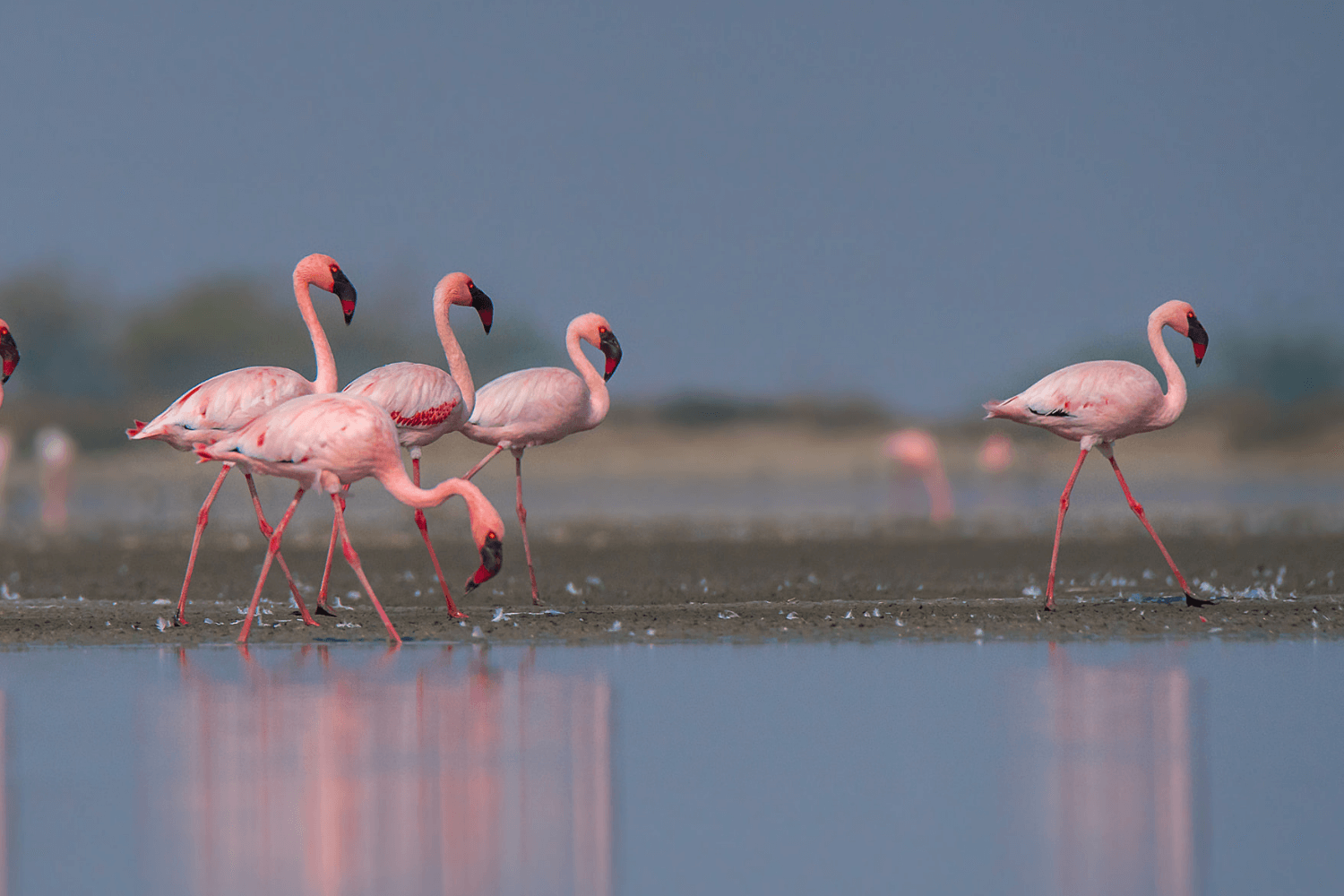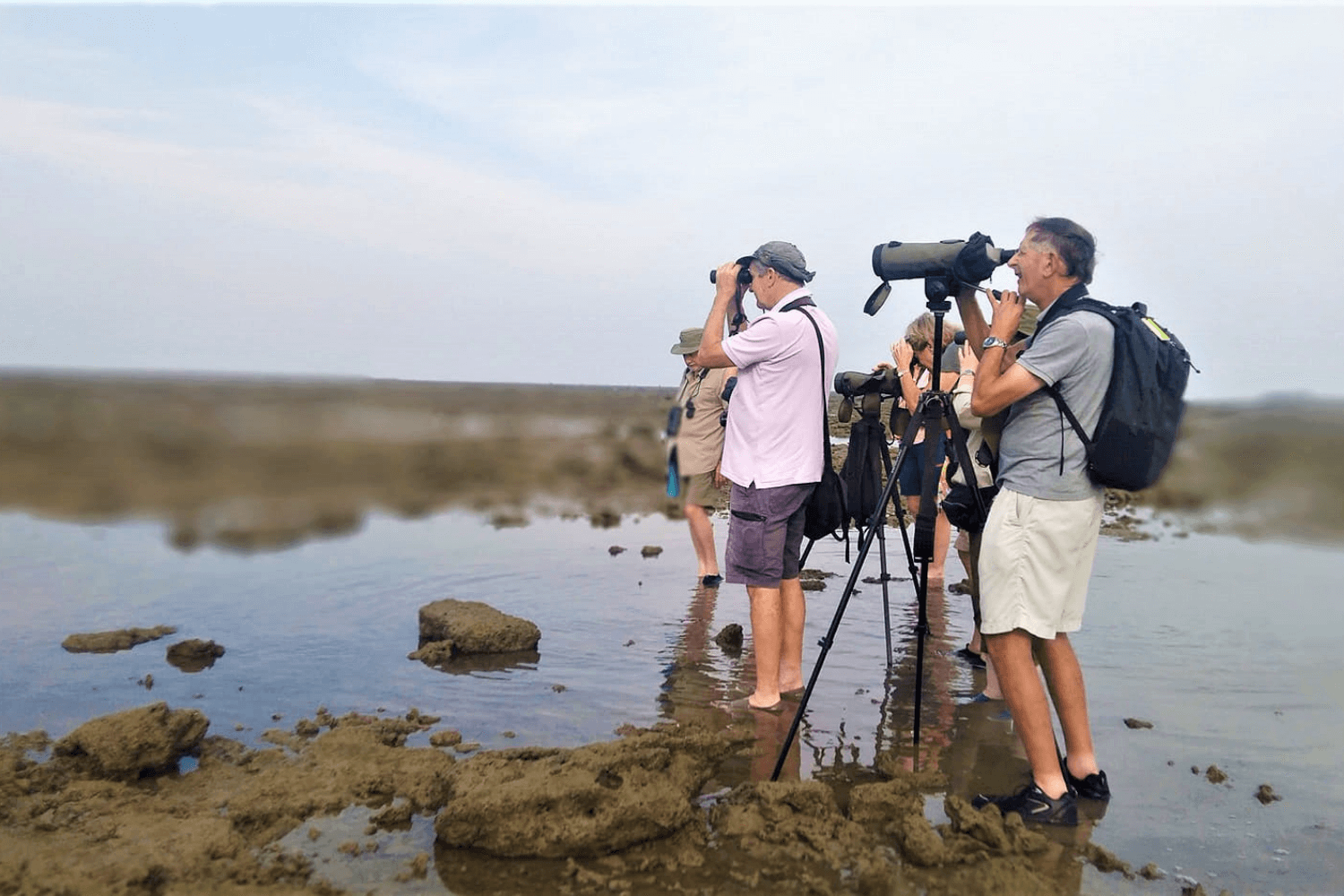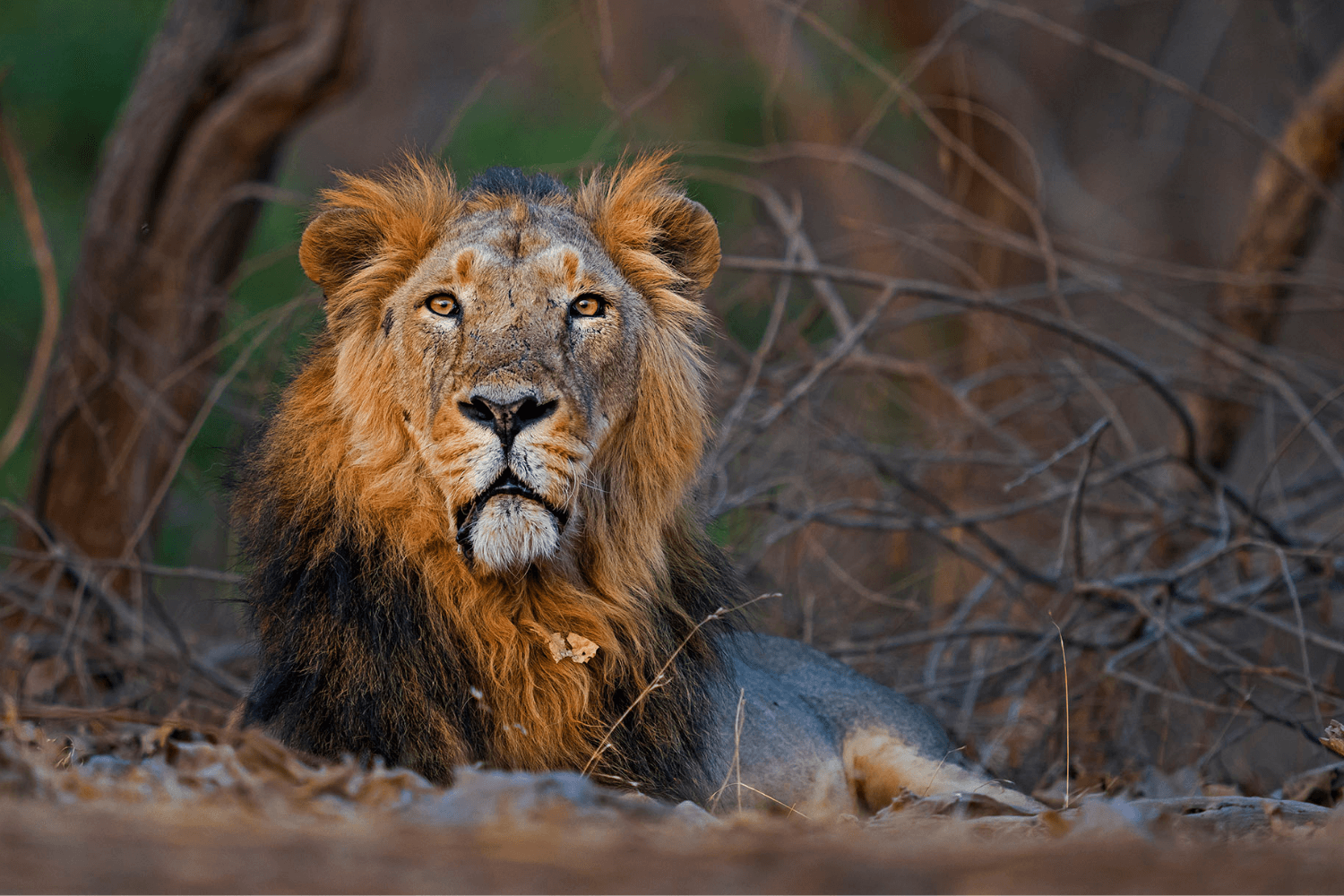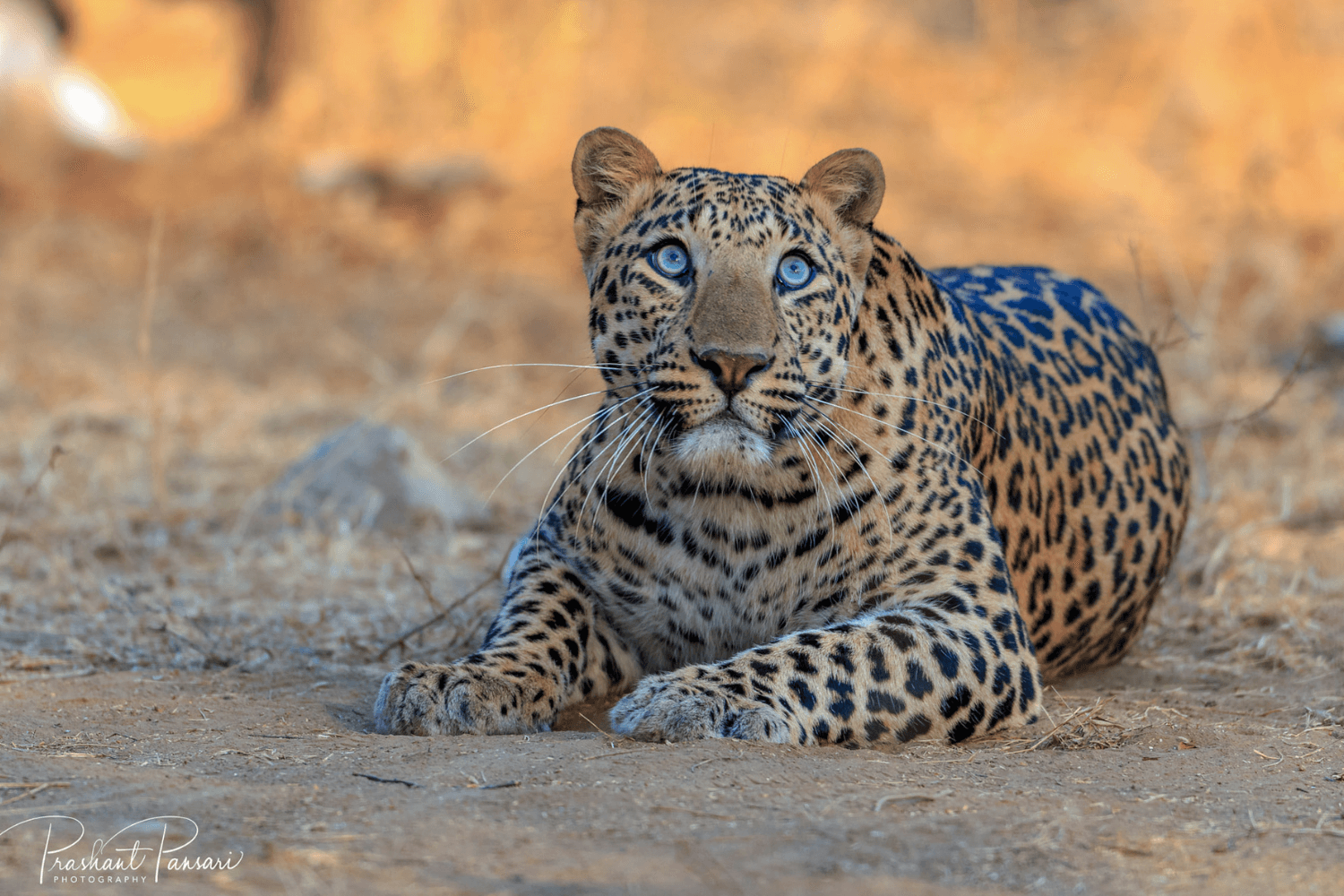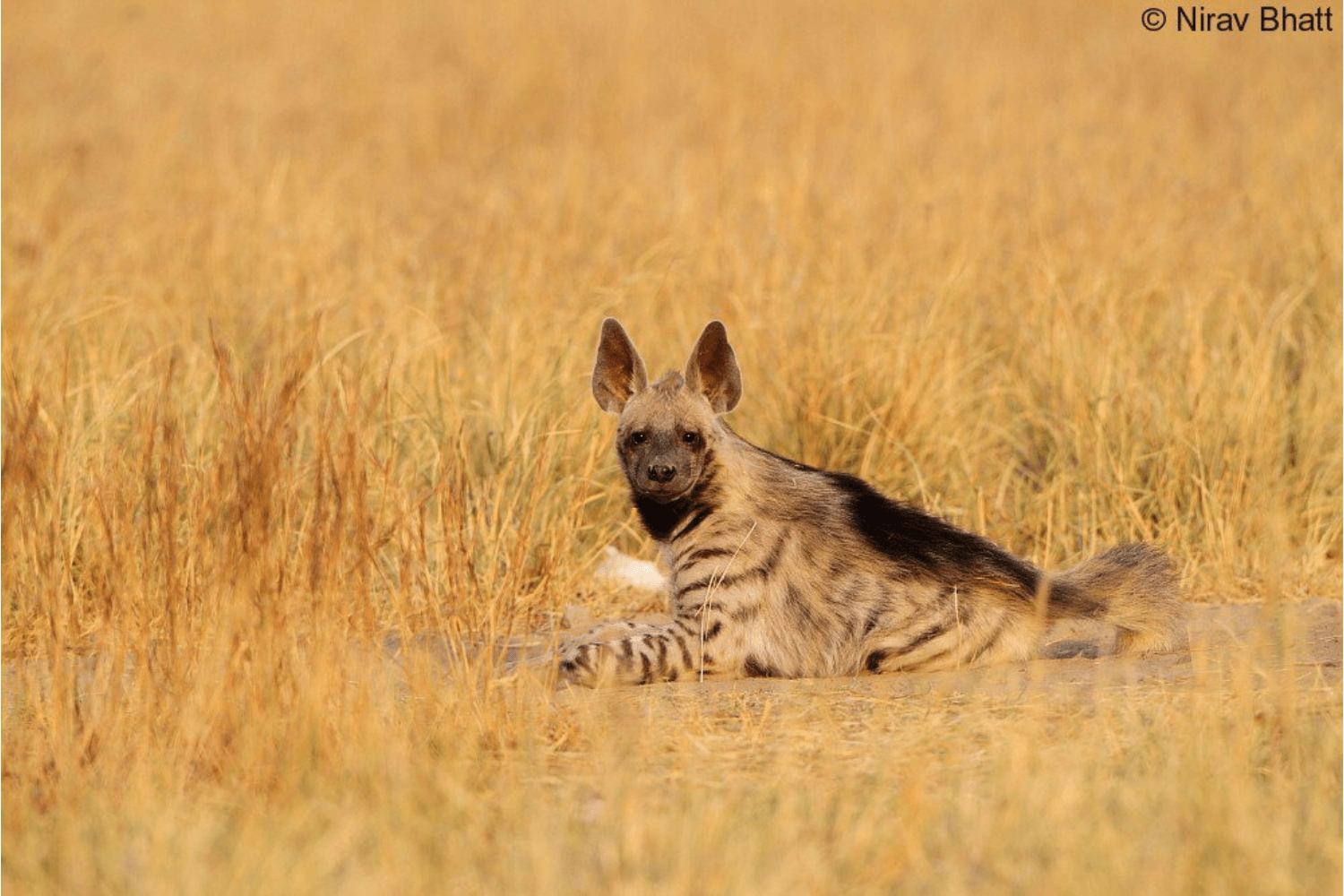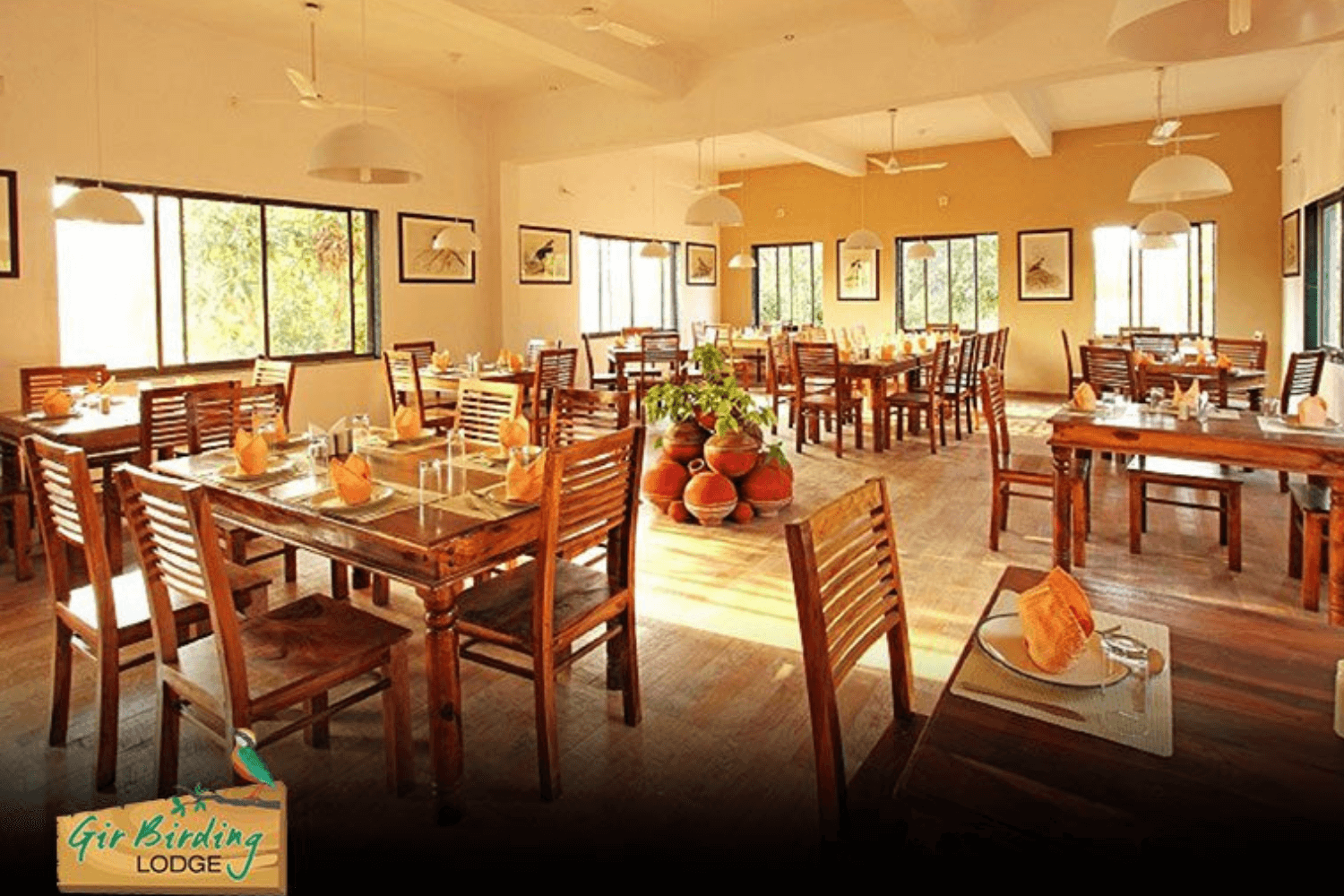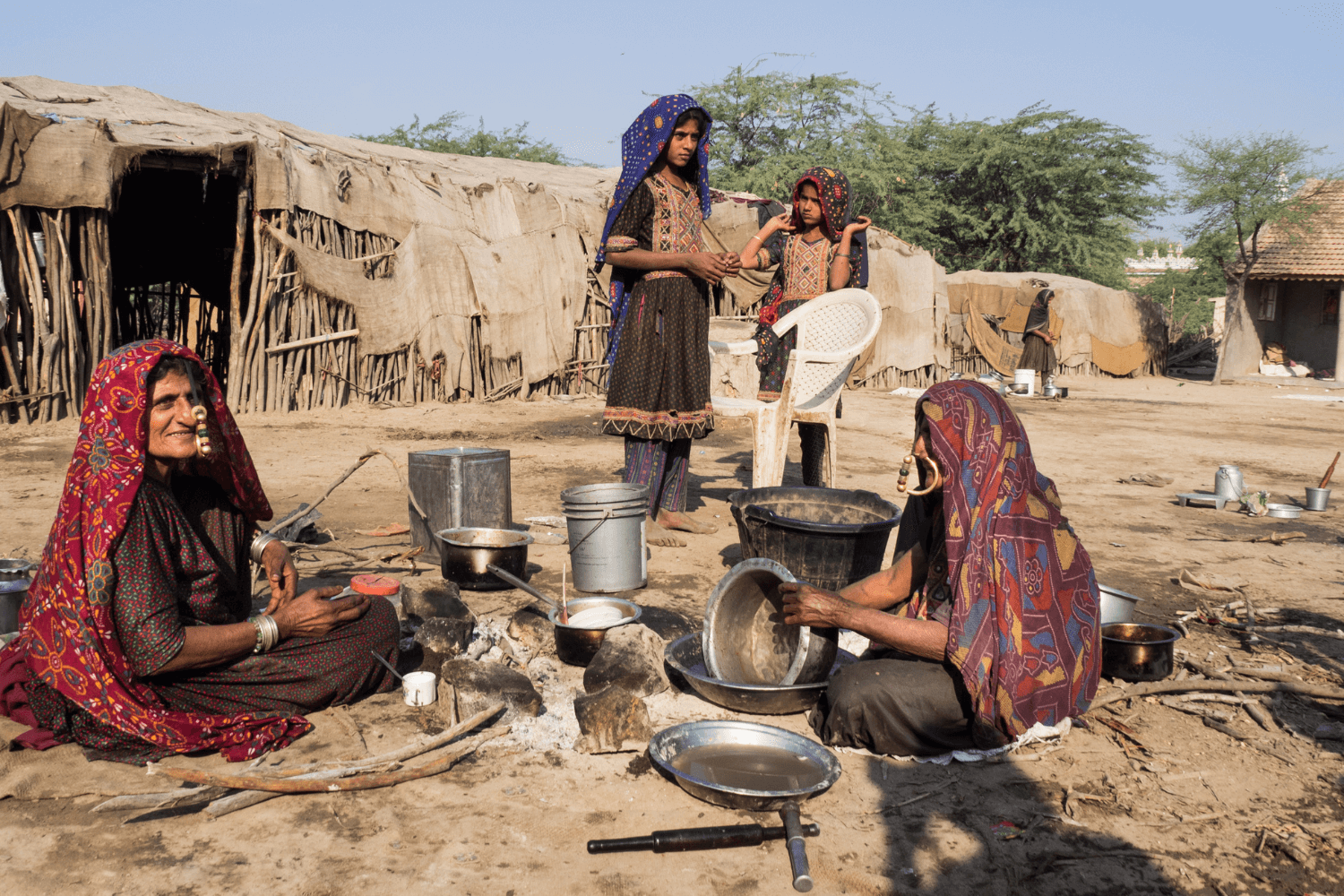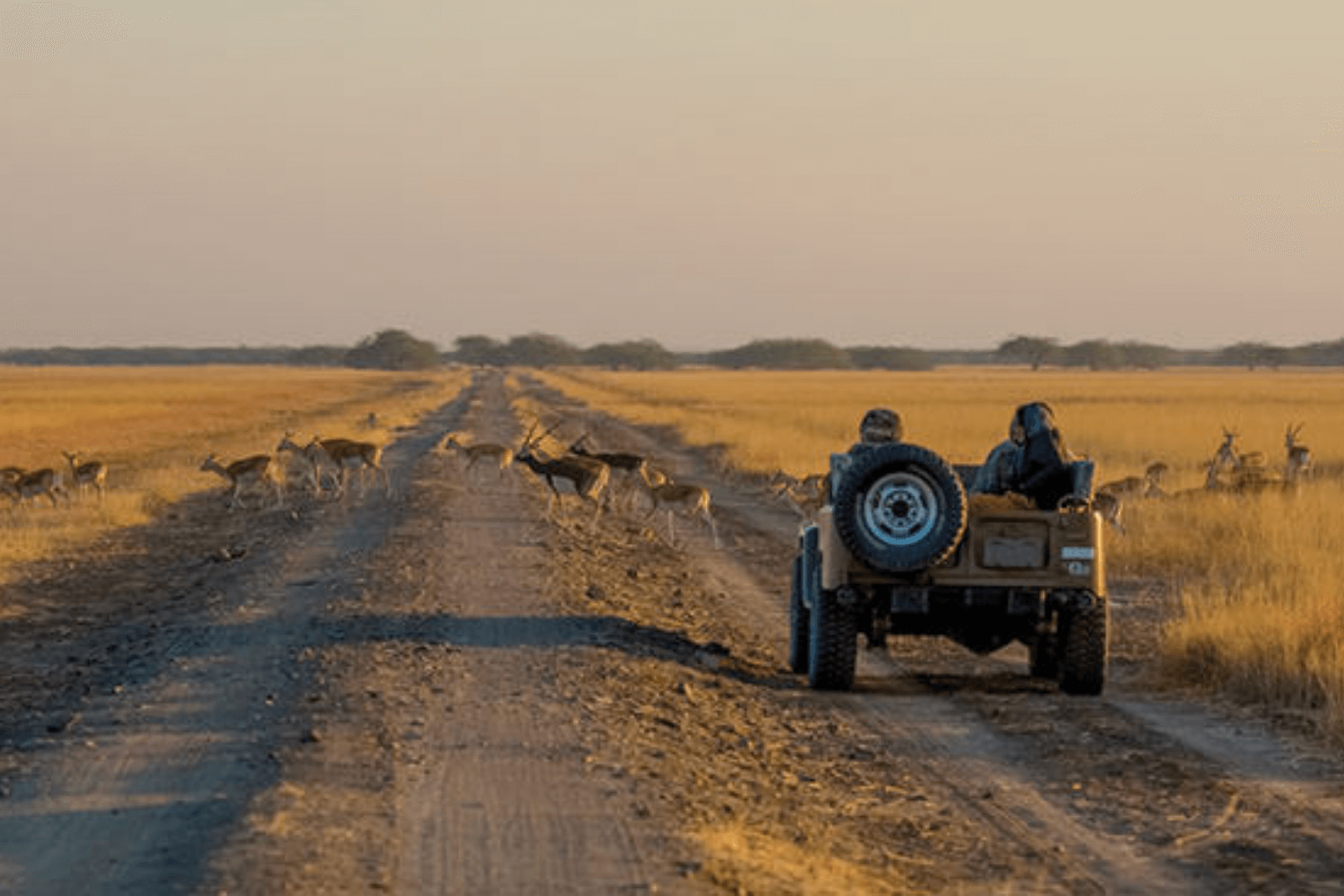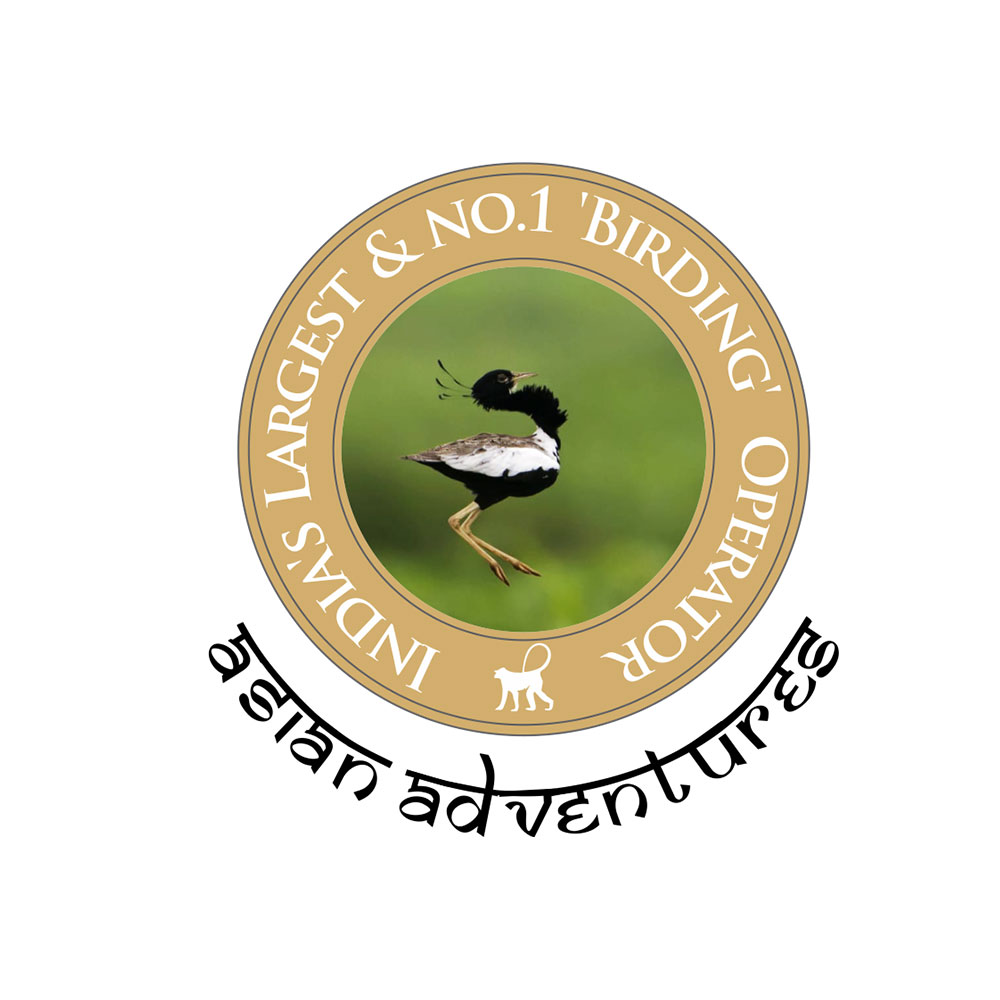Overview
Coastal Gujarat, particularly the Gulf of Kutch and the Saurashtra Region, is teeming with wildlife. Not only is the region home to Gir National Park, the only home of the Asiatic Lion, but also lies on a migratory flyway, meaning that it becomes one of the most popular birding destinations in the winter. From amazing birdwatching and wildlife destinations, each with something unique to offer, to the warmth, affection, and hospitality of the people of the region, this tour offers you a myriad of unique and memorable experiences.
Jamnagar is blessed with a mix of saltwater and freshwater habitats, providing rich grounds for the resident and migratory bird species to flourish. The nearby Khijadiya Bird Sanctuary is a popular birdwatching area due to this unique ecology. Birds of both the seashore and freshwater habitats are found here and include Great Crested Grebe, Red-naped Ibis, Black-necked Stork, Black-winged Stilt, Brahminy Kite, Common Crane, Grey-headed Swamphen, Greylag Goose, Greater, and Lesser Flamingos, Dalmatian Pelican, and many duck species. Other wildlife found in the sanctuary included the Golden Jackal, Indian Hare, Jungle cat, and Nilgai.
Gir National Park was established in 1965 for the protection of the Asiatic Lion. The forest is mainly of dry deciduous and scrubs types, with many perennial rivers and streams crisscrossing the area. The wildlife of Gir includes large predators such as Asiatic Lion and Leopard, herbivores such as Spotted Deer, Sambar, and Nilgai, a variety of bird species, and more.
Velavadar National Park lies inland from the Gulf of Cambay on the west coast of India. Created for the conservation of the Blackbuck, it is a tiny but unique grassland ecosystem. The Indian Grey Wolf and the Golden Jackal are the main predators in the park. Other mammals likely to be seen are Bengal Fox, Indian Hair, Indian Desert Gerbil, Jungle Cat, and Nilgai.
Velavadar is also of particular interest to birdwatchers. One can spot many species of birds of prey, like Montagu’s and Pallid Harriers, Black-winged Kite, Shikra, and Short-toed Snake Eagle, as well as other birds like White-browed Bush Chat, Ashy-crowned Sparrow-Lark, Rufous-tailed, and Crested Larks, Desert and Variable Wheatears, and Great Grey and Long-tailed Shrikes. Common Crane and waders can be spotted on the Alang River.
My awesome week in coastal Gujarat
Many know Gujarat for its festivals, culture, and even cuisine. I, however, have always been drawn to the wildlife of Gujarat. Not only is this state rich in wildlife, but many of the birds and mammals found here are unique to the region, or at least best seen here. Thanks to this, Gujarat has been a place I have been birding plenty of times. On this particular trip, instead of briefly visiting many places, I decided to spend time in a few of my favorite places, with a tour of Gir National Park, Jamnagar, and Velavadar.
Instead of starting off in Ahmedabad as usual, my travels this time began in the city of Jamnagar. While the city is well-known for its temples, forts, and palaces, birding near Jamnagar is also extremely promising, and I was more interested in the nearby Khijadiya Bird Sanctuary. This estuarine area has a lovely mix of both fresh- and saltwater habitats, meaning that you can get the opportunity to see coastal waters, along with freshwater waterfowl, and of course, a few scrub birds in the surrounding bushes.
Not only is the variety of birds here amazing, but also the sheer numbers! This place falls on a migratory highway of sorts, and is an important fuelling station for birds, meaning they gather here in the hundreds and thousands. I have never seen so many sandpipers, gulls, terns, and more in a single place, and my joy at seeing this sight was only slightly dimmed by my frustration in trying to identify what all species were in the large flocks.
I also managed to see Jungle Cats here, a usually shy small wild cat species, and a prized sighting for wildlife, perhaps even more so than their big cousins. A mother with two adorable kittens crosses my path at quite a leisurely pace, briefly pausing to give me a warning look. Needless to say, I ended up with many photos of these cuties!
After spending almost two full days birding here, I headed the next day to what is perhaps the state’s best-known wildlife destination, and the main destination for Gujarat wildlife tours, the Gir National Park. Of course, my main target here was the Asiatic Lion, an animal seen nowhere else in the world. However, my safaris into the park, my time in Gir Birding Lodge, and my occasional village visits taught me so much more.
I didn’t think at all that Gir would be a place of interesting culture, and that it was just another wildlife destination. But that is not true at all. The tribal culture and history around the area are fascinating.
The area in and around Gir is inhabited primarily by the Siddi and Maldhari tribes. Maldharis are descendants of nomads and are of various castes and creeds, who spend much of the year traveling as they graze their livestock. The Siddi are an ethnically African tribe, descended from the East African Bantu peoples, descended from merchants, sailors, indentured servants, slaves, and even mercenaries.
I would never have learned all these interesting facts had I not taken a little time to see what was around me.
From what has been my longest stay in Gir (until now), I traveled to Velavadar National Park, or Blackbuck National Park, where my target was the graceful-looking Blackbuck. This antelope has been a dream for me to see, and in my opinion, it is among the most beautiful of India’s animals.
The grasslands of Velavadar are stunning, a sea of gold, and a Velavadar wildlife safari is like a strange cruise. And traveling through this golden sea are the majestic Blackbucks. What grace they have! Getting to see and photograph these animals was perhaps one of the most enriching experiences of this trip.
But Velavadar isn't just about Blackbucks. The Indian Grey Wolf and the Golden Jackal are the main predators in the park, and I was lucky enough to see both (although the wolves I saw were far off). I also managed to spot a few Jungle Cats, a lifer for me. The birds of Velavadar are also fascinating. Montagu’s and Pallid Harriers roost here in great numbers and are a great sight against the dawn and dusk skies. In addition, I also saw many wheatears, larks, and shrikes in the grassland, as well as a large flock of Common Crane along the river.
After my amazing week here, it was sadly time to go back home. But the memories of Kutch, Gir, and Velavadar will remain etched in my memory forever.
Please Note, the Acronyms in Bird Species
R stands for Resident Birds
S stands for Summer
W stands for Winter

Meals: Breakfast
Accommodation: Hotel President
Arrive in Jamnagar from Bhuj, Ahmedabad, or Mumbai. You will be met by our representative and transferred to your accommodation, where you can freshen up and relax. If time permits, you can spend some time exploring the city. The city is well-known for its temples, forts, and palaces, and Lakhota Lake in the city is a great place for some casual, idle birding.
Overnight Stay.

Meals: Breakfast, Lunch, and Dinner
Accommodation: Hotel President
Today, we explore the coastal areas along the Gulf. An essential stop on a migratory flyway, this area is one of the finest birding stretches along the western Indian shore. You are likely to see great numbers of waders like Crab-plover (W), Greater and Lesser Sand Plovers (W+S), Eurasian Oystercatcher (W+S), Ruddy Turnstone (R), Great Knot (W), and many more.
Overnight stay.

Meals: Breakfast, Lunch, and Dinner
Accommodation: Gir Birding Lodge
Depart at dawn for Gir National Park (5-6 hours) and check in at Gir Birding Lodge. You will be there in time to go on an afternoon safari to look for birds. The park is a mosaic of different dry forest types, and, apart from Asiatic Lion, is home to a great variety of wildlife including leopards, deer, Wild Boar, and more, as well as a large variety of birds to keep you company!
Overnight stay.
Key species: Asiatic Lion, Leopard, Sambar, Spotted Deer, Nilgai, Western Osprey (R), Indian Stone-curlew (R), Red-naped Ibis (R), Changeable Hawk-Eagle (R)

Meals: Breakfast, Lunch, and Dinner
Accommodation: Gir Birding Lodge
Explore the forests of Gir Wildlife Sanctuary with the help of morning and afternoon drives. The forests of Gir are the last home of the Asiatic Lion. Another big cat found here in plenty is the Leopard. It also has a large population of Chital or Spotted Deer, Sambar, Nilgai, Wild Boar, and other wildlife. A number of attractive Birds can be seen too, such as Tickell’s Blue Flycatcher (R), Common Woodshrike (R), Indian Scops Owl (R), and Mottled Wood Owl (R), and more.
Overnight stay at Gir Birding Lodge.

Meals: Breakfast, Lunch, and Dinner
Accommodation: Gir Birding Lodge
Two more safaris in Gir to make the most of your visit here. Apart from the animals and birds, Gir is also home to many interested plants and trees adapted to the dry conditions. A chat with your guide and safari driver will let you in on some interesting factoids of the area, including the unique tribal cultures of the region.
Overnight stay.
Key species: Asiatic Lion, Leopard, Sambar, Spotted Deer, Nilgai, Oriental Honey Buzzard (R), White-eyed Buzzard (R), Indian Golden Oriole (R)

Meals: Breakfast in Gir, Lunch, and Dinner in Velavadar
Accommodation: Blackbuck Safari Lodge
It’s time to bid the big cats adieu and head to Velavadar National Park. We will travel almost six hours from Gir National Park to Velavadar and check-in at Blackbuck Lodge. Created for the conservation of the Blackbuck, Velavadar is a small but stunning grassland ecosystem, home to many grassland birds and animals. Indian Wolf and Striped Hyena are also here in decent numbers, and make for interesting sightings
Overnight stay

Meals: Breakfast, Lunch, and Dinner
Accommodation: Blackbuck Safari Lodge
Today, you have the full day to explore the golden grasslands of Velavadar. Although Velavadar was created for the protection of its Blackbuck population, a variety of grassland birds, including sandgrouse, larks, pipits, shrikes, and raptors, make for amazing birding. In the evening, witness a massive harrier roost, one of the largest in the world.
Overnight stay
Key species: Blackbuck, Striped Hyena, White-browed (Stoliczka’s) Bush Chat (R), Desert Wheatear (W), Isabelline Wheatear (W), Variable Wheatear (W), Crested Lark (W), Pallid Harrier (W), Common Babbler (R)

Meals: Breakfast, Lunch
Accommodation: None
You will have the morning to go for a productive birding session in the park. After your birding session, check out and drive to Ahmedabad (4 hours) at noon. You will be transferred to the airport for your onward flight.
Tour Ends.
Highlights
- Excellent birding opportunities, with a rich variety of avifauna
- Interesting road journeys through the unique landscapes of the region
- Excellent mammal diversity, with unique species such as Asiatic Lion, Wolf, Striped Hyena, and more
- Possibility of extension and customization
- Stay in some of the region’s best ecolodges
- Farm-fresh and delicious organic Indian meals
Included
- Accommodation on double sharing basis Meals as per the itinerary
- Coastal visit in Jamnagar A visit to Velavadar for wildlife viewing and birding
- Jungle visits in Gir National Park in 4WDs A dedicated birding guide | All surface transfers by a private air-conditioned vehicle
Video
Location
Stories
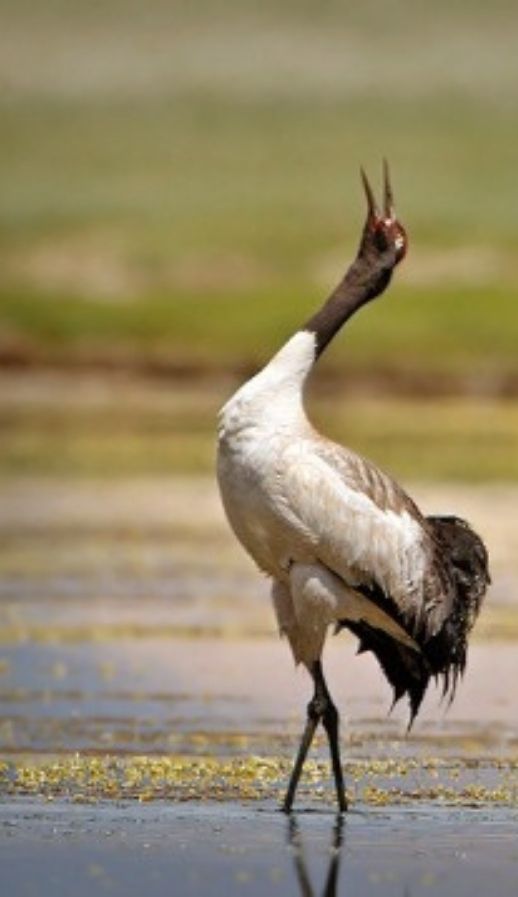
Ladakh
North India, the land of Ladakh, looks as though it was made for birdwatching and photography.

Gir National Park Gujarat
Sometimes it is not just the species spotted but also the amazing moments. Some of our guests had the unique opportunity to witness the mating of Asiatic Lions in the Gir Forest, truly a special moment.

Delhi
Surajpur is an amazing wetland close to the nation’s capital. Apart from being one of the monsoon homes for the Bristled Grassbird, it is also home to another sought-after species: the Bengal Bush Lark.

Rajasthan
One advantage of living near the birding hotspot of Bharatpur is that you can see some amazing birds, like the graceful Sarus Crane, in your backyard during this lockdown


